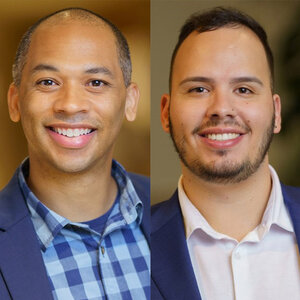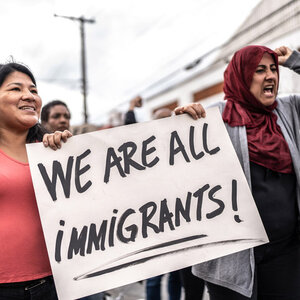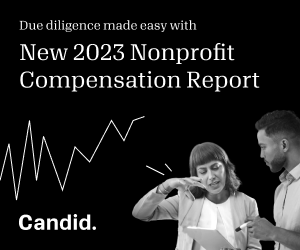A primer on social change (spoiler: fund the movement)

As we move toward the close of a tumultuous year marred by mass shootings, rising homelessness, and humanitarian catastrophes in Gaza, Sudan, Congo, and beyond, foundations committed to the greater good must apply urgency to the question of how they can help forge a more safe, just, and equitable world in 2024. While for many philanthropists the reflexive approach is to invest in rapid response and direct-service interventions, they can and should also incorporate macro-level strategies in their grantmaking portfolios. For funders ready to grapple with this essential work of systems change, the following guidance may prove useful: 1) fund at the scale of the problem; 2) recalibrate expectations; and 3) break out of siloed thinking.
Fund at the scale of the problem
On any given day in America, there are more than 500,000 individuals experiencing homelessness and nearly two million are incarcerated. Dozens of states across the nation have moved to restrict voting rights and women’s reproductive healthcare options. Hate crimes continue to rise, with more than 11,000 incidents recorded by the FBI in 2022. Cities are grappling with supporting rising numbers of asylum seekers escaping violence and persecution. Record heatwaves, wildfires, and destructive floods continue to wipe out and displace communities. Pick your metaphor—missing the forest for the trees, a Sisyphean task, a thumb in the dike—the reality is the same: philanthropy can never spend its way out of the societal problems it seeks to alleviate. This truth is further underscored by the annual giving limits many funders put in place, ensuring that endowments will live to see another day—but so too will the problems they would seek to ameliorate.
Consider as well that no amount of direct services will improve affordable housing zoning regulations, immigration enforcement practices, or same-sex marriage benefits. If funders mean to support rent-burdened households, unaccompanied migrant children, or LGBTQIA+ community members, they must acknowledge the role that laws and systems play in generating inequitable outcomes, and fund accordingly. It’s also essential that funders remember that the movement organizations fighting for a more just world are doing just that: fighting. Whether seeking to expand access to governmental benefits, disrupt the school-to-prison pipeline, or update civil or labor rights, they face an organized and well-funded opposition.
This is what movement leaders mean then when they urge philanthropy to “fund us like you want us to win.” Deep, sustained investing in movement organizations is an essential commitment philanthropy must make if it is serious about addressing the chronic inequities experienced by marginalized groups.
So, what would it look like for us to fund our grantees like we want them to win?
Recalibrate expectations
Headlines often focused on hyper-partisan policy debates and government dysfunction contribute to a skewed analysis of how social conditions can be improved and how “wins” are defined. For instance, holding the line against efforts to slash entitlement programs and roll back environmental protections are real victories that contribute to community well-being, but this may not be obvious in traditional funder evaluations of outcomes. In addition, philanthropists would do well to embrace the “long game.” The work being done now by grassroots organizations to build power and transform narratives is an important part of shifting the Overton window and setting the stage for policy victories and culture change in the future. For example, recent breakout wins in California to expand medical coverage to all residents regardless of immigration status were made possible by the tireless work of advocates often dismissed when initially proposing such bold reforms.
Implicit in victories like these was the foresight of funders to think local, recognizing that ideas that may be nonstarters in Congress are in fact often within reach at the state or local level. These foundations understand the work of regional movement organizations as important laboratories for leveraging the power of democratic processes for good. Remember as well that policy threats to economic justice (or any issue), such as restrictions on union organizing, are often tested in one state before being refined and exported to other states for replication.
Foundations must also reset their expectations about the types of organizational capacity gaps that hinder movement work. Building deep benches of skilled and committed staff is a challenge for any nonprofit, given the high rate of churn in the sector due to low wages and burnout. Providing flexible funding to a movement organization to shore up their compensation and benefits packages may not immediately feel like an investment in combatting Indigenous erasure or improving educational outcomes for first-generation college students, but if those organizations doing the work to achieve those outcomes are not able to thrive, their communities will be worse off for it.
In addition, our toxic political environment means that groups working toward a more equitable society often come under attack. Investing in the physical and digital security of organizations and the emotional well-being of their leaders and staff is a prerequisite to any funder expectation that they meet grant deliverables. People are the greatest asset of any movement, and they must be given the resources needed to protect themselves against rising Islamophobia, antisemitism, racism, homophobia, transphobia, and other forms of discrimination as they work to build a more just multiracial democracy.
And how are we supporting the local institutions and leaders advancing bold work that, if successful, would actually bring us closer to our goals of improving community outcomes?
Break out of siloed thinking
Some four decades after Audre Lorde made the oft-repeated observation “there is no such thing as a single-issue struggle because we do not live single-issues lives,” philanthropy—which often expects its grantees to work collaboratively—rarely breaks out of funding silos to embrace intersectional strategies. This gap prevents community-based organizations that work at complex intersections from securing funding when they don’t fit neatly into a prescribed funder portfolio. Understanding the links between, for example, racism and maternal health or climate change and worker rights, will require funders to sharpen their own political analysis and, in doing so, will reveal new avenues for investments in building movement ecosystems.
Another version of siloed thinking is the predictable ramp-up of funding for civic engagement in the immediate run-up to presidential elections. For community organizing groups to truly leverage these investments in get out the vote (GOTV) efforts, they need the funding well before and after election interest peaks. In other words, they need sustained funding for issue-focused, base-building work. This means resourcing them to build actual solidarity with community residents over time by learning about their concerns and working on various solutions together. This approach is what forges the type of trusting relationships that can more readily be activated during GOTV work. Funders must understand that election cycles are situated within a larger arc of social change efforts that take years, if not decades, of organizing and deploy more long-term civic engagement resources.
This is not to say, however, that election-year investments are not important. Indeed, as Sen. Debbie Stabenow (D-MI) once reflected, it can be easier to work toward and spend money on electing the “right” person than to work to convince the “wrong” person to do the right thing. This “both and” approach—long-term base building and election-year mobilizing—brings into consideration the frequently misunderstood rules around permissible 501(c)(3) and 501(c)(4) activities. These IRS regulations deserve their own exploration (and Bolder Advocacy has a trove of resources for funders of all types), but the key takeaway is that in many instances funders can support grantees’ electoral 501(c)(4) work and that doing so can provide a powerful complement to the issue-based work of 501(c)(3)s.
Now, how might we expand grantmaking to account for the second-order impact of intersectional and civic engagement work?
Looking ahead
While shifting to funding at the scale of the problem, recalibrating expectations, and breaking out of siloed thinking can serve as a convenient set of mental cues for rethinking grantmaking, the goal is not to abandon direct relief or abstain from election year opportunities. Rather, we call on the sector to collectively consider the ways in which each institution can take hold of a piece of the bigger picture and fund the movement like we want them to win.
Kevin Douglas is senior director of national programs and Cairo Mendes is director of state and local programs at Grantmakers Concerned with Immigrants and Refugees.
and other forms of discrimination








To strengthen America’s democracy, invest in youth civic learning